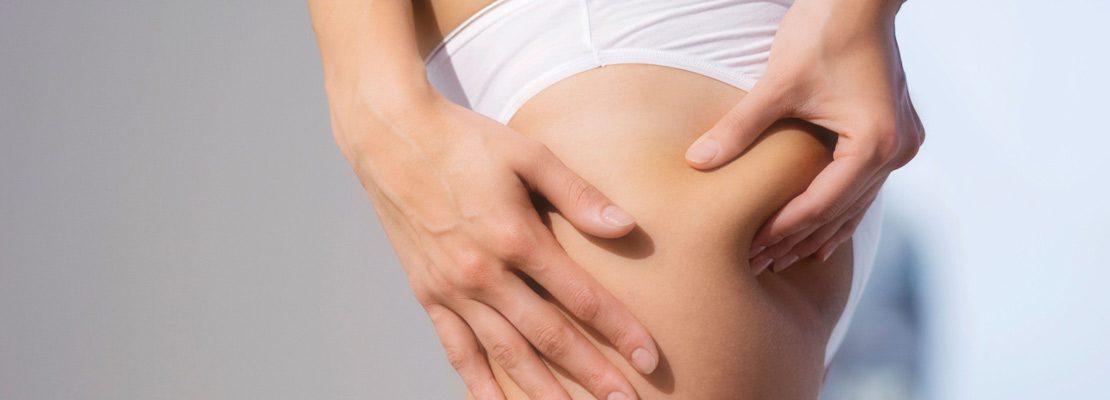
Cellulite, along with weight gain, is among the most serious concerns for women around the world. There is a connection between the two, but it’s not only the overweight that fall prey to the orange skin peel syndrome. It is often seen on the thighs of many young and thin women, as well as those who regularly work out or lead a very active life.
WHAT ARE THE CAUSES OF CELLULITE?
Physicians believe the problem lies in the topmost subcutaneous layer of fat. It manifests as a direct disturbance in blood and lymph circulation and change to cell exchange. It leads to the containment of waste products, fluids, toxins and other metabolites in the cells.
This increases the connective tissue and alters its structure. As a consequence, the skin thickens and small clusters and protrusions form on its surface, which resemble the skin of oranges.
The condition is defined as gynoid lipodystrophy. Due to differences in skin structure, men almost do not suffer from cellulite. Unfortunately, it affects almost 90% of women to varying degrees and at different times.
RISK FACTORS
- Poor Heredity: If your family is predisposed to cellulite, it is likely to surface in you.
- Age: As the years go by, connective tissue and muscles naturally weaken and metabolism slows down. This provokes changes in the adipose tissue and stimulates cellulite.
- Weight Gain: True, thinner women also have the orange peel syndrome, but it's much more likely to worsen with weight gain. Weight fluctuations (frequent weight gain and weight loss) also poorly affect connective tissue and deepen the problem.
- Poor Nutrition: Poor choices in your diet definitely lead to gaining weight and cellulite. These include highly processed foods with plenty of synthetic enhancers (E-th); fast food with lots of fat and salt; pastry sweets and desserts made with white refined flour, refined sugar and its substitutes, hydrogenated fats (trans fats); the lack of vegetables and fruits in the menu etc.
- Sedentary Lifestyle: Prolonged sitting flattens the buttocks and thighs, interrupts the circulation of blood and lymph, and speeds up the sedentary processes. Also, it leads to muscle atrophy and is also responsible for the deterioration of the connective tissue.
- Hormonal changes in puberty, pregnancy and various endocrine disorders may also be the basis for cellulite.
- Harmful habits such as smoking, drinking alcohol and binge drinking; wearing too-tight clothing, and so on.
Some of the risk factors for cellulite are easy to control. This means that following a well-designed individual program featuring a balanced diet and the correct physical activity can reduce cellulite by a significant margin. Some cosmetic products are also beneficial as they improve both blood and lymph circulation.
CELLULITE NUTRITION GUIDELINES
There are no miraculous diets, but the principles of healthy eating can definitely help. This means minimum to no processed and canned foods, no refined products (white flour, white sugar), severe reduction of oily and fried foods, salt and processed meat products.
Recommended are light meats and fish, low-fat dairy products, legumes, whole grains, seeds and nuts. You need lots of vegetables and fruits – best when raw or only slightly heat treated. Among the most beneficial are those that contain fiber, vitamins and bioactive substances the most – onions and garlic, cabbages, cauliflower, broccoli, spinach, salads, tomatoes, carrots, zucchini, pumpkins, apples, plums, figs, apricots, strawberries, citrus and so on. Drink about 2l of water daily.
PHYSICAL ACTIVITY
Movement not only activates the muscles, but firms the connective tissue. It accelerates circulation at the cellular level and improves the drainage of waste products. Improves breathing and nutrition. Burns fat to meet the increased energy needs. This affects the healing of all tissues – including the subcutaneous fat layer, where cellulite occurs.
It is best to contact a specialist who, depending on your individual condition, age and fitness ability, will assign a custom exercise program. However, there are always a easy-to-do activities in your day-to-day life to get you started.
- Climbing Stairs: Climbing and going down stairs several times a day for at least 4-5 floors puts the hip and thigh muscles to work and does wonders with your physique and cellulite. If you don’t train, start with going up and down one or two flights of stairs and gradually increase that number.
- Running or Speed Walking: Choose which one depending on your current physique. You can alternate between the two, and need to perform either at least 4-5 times a week for at least half an hour.
- Jump Rope: Jumping rope is an extremely useful and affordable exercise, which creates an overall toning effect over the whole body and delivers the necessary strain on the hip and glute muscles. Increase duration gradually.
- Cycling, swimming, aerobics, bodyweight exercises – everything you enjoy and that activates your muscles is welcome.
- Sign up for ballroom dancing.
Getting rid of cellulite is a complex task that tends to be unachievable. But to reduce cellulite and improve your appearance to the fullest, while strengthening your overall health is quite possible.
The earlier you start, the better. Act now!

Leave a comment